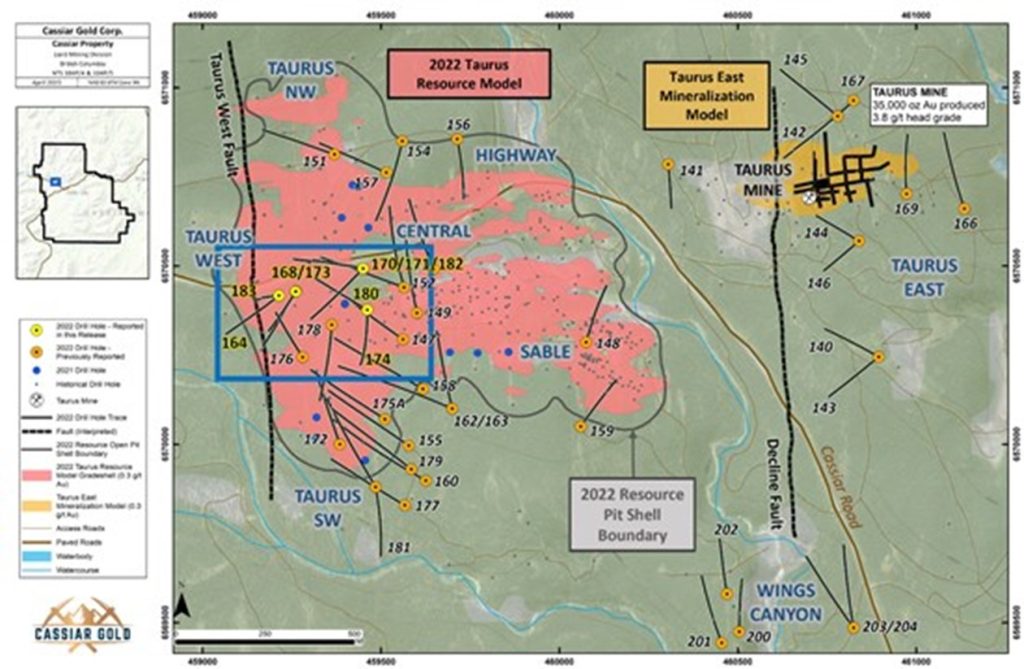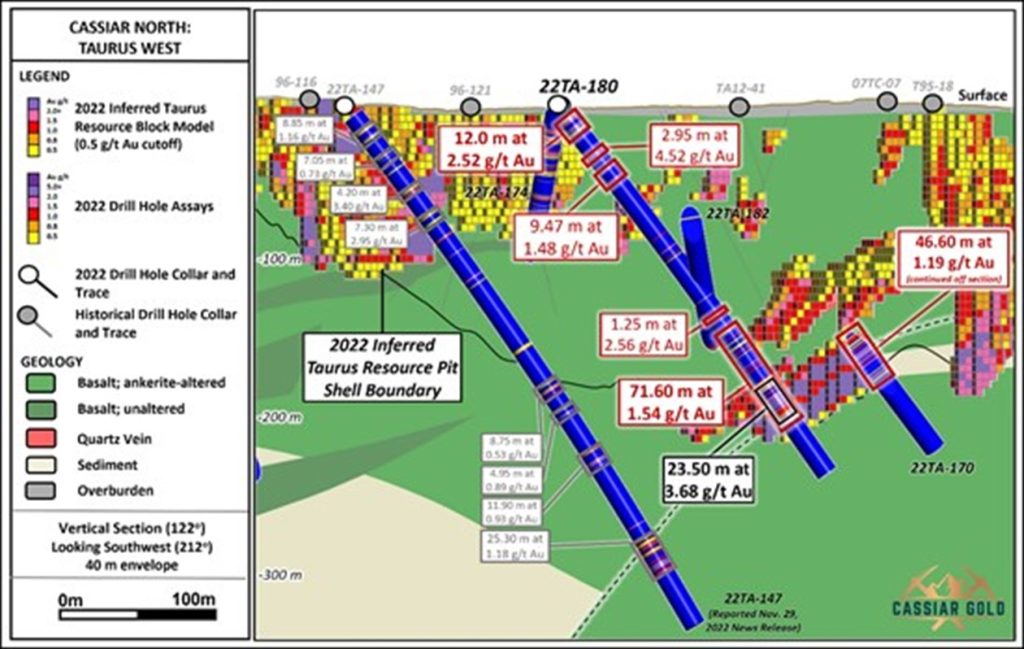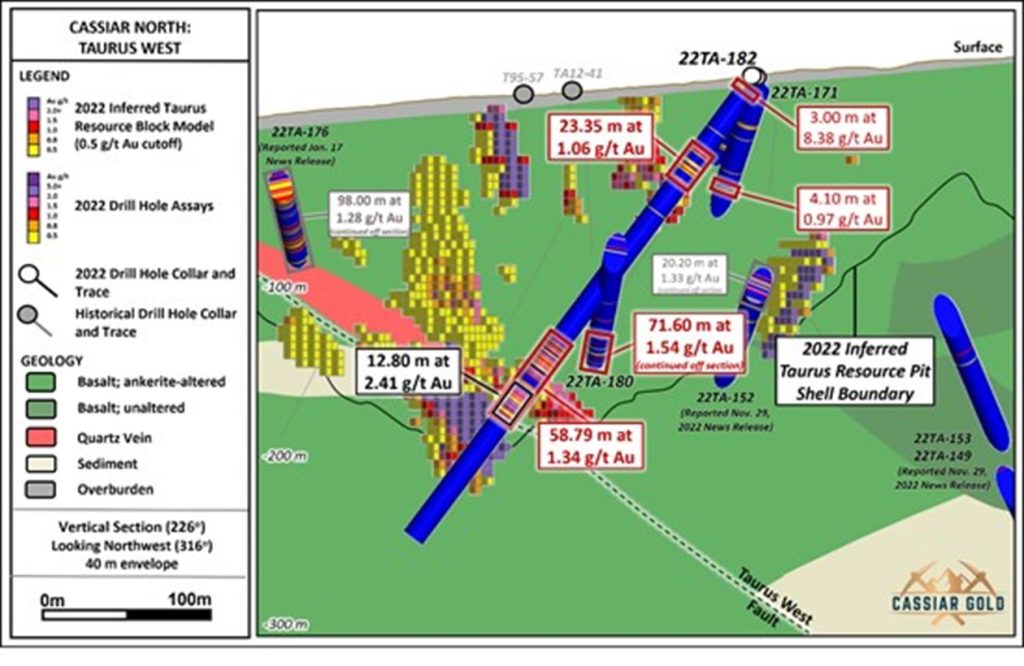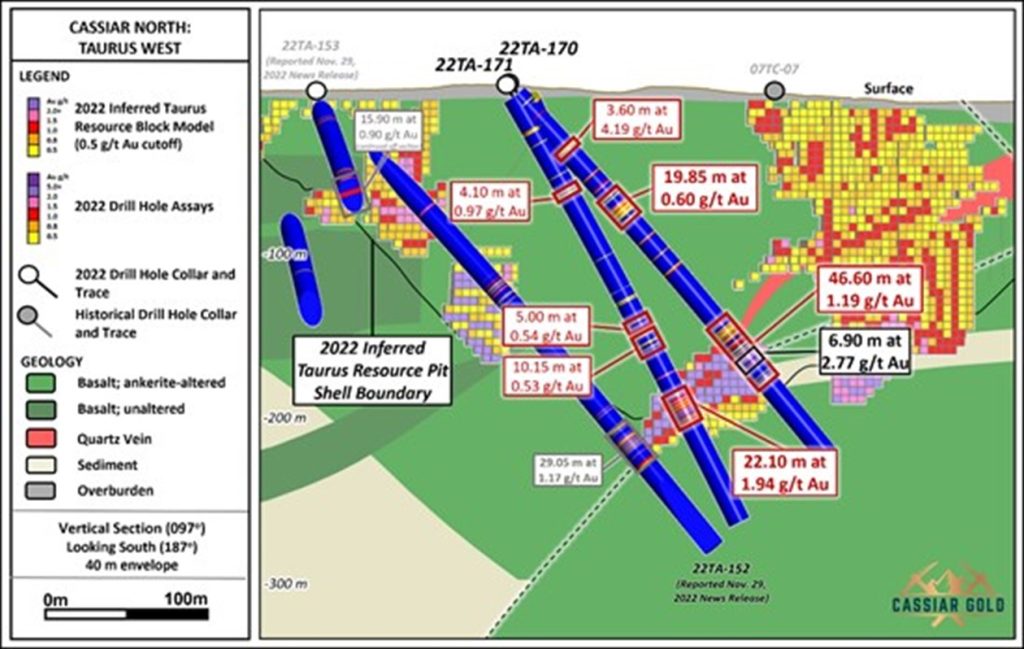
CASSIAR GOLD EXPANDS GOLD MINERALIZATION AT TAURUS WEST INTERSECTING 71.6 M OF 1.54 G/T AU INCLUDING 23.5 M OF 3.68 G/T AU

Cassiar Gold Corp. (TSX-V: GLDC) (OTCQX: CGLCF) is pleased to announce assay results from an additional nine diamond drill holes that were part of the 2022 exploration program completed at and near the Taurus Deposit, located on Company’s flagship Cassiar Gold Property. Results reported here contribute to the progressive expansion of mineralization both within and near the footprint of the Taurus Deposit and further demonstrate continuity of a higher-grade corridor of gold mineralization at the western extent of the deposit.
Cassiar Gold’s 2022 exploration program comprised 23,000 meters in 70 diamond drill holes focused on strategic areas of the Taurus Deposit, as well as significant vein prospects in Cassiar South and other brownfields targets. Results from 13 drill holes totaling 5,259 metres of drilling from this program are yet to be disclosed as the Company continues to await the return of additional assay results.
Highlights from the Taurus West area:
- Drill hole 22TA-180 intersected 71.6 m of 1.54 g/t Au from 177.5 m down hole, including 23.5 m of 3.68 g/t Au, expanding mineralization beyond the resource block model along the Taurus West Fault (Table 1).
- Drill hole 22TA-182 intersected 58.8 m of 1.34 g/t Au from 194.7 m downhole, including 12.8 m of 2.41 g/t Au, expanding mineralization beyond the extend of the resource block model.
- Drill hole 22TA-174 returned multiple mineralized intercepts, including:
- 77.2 m of 0.67 g/t Au from 12.3 m downhole, including 24.3 m of 1.13 g/t Au, confirming near-surface mineralization at Taurus West, and
- 24.3 m of 1.13 g/t Au, extending mineralization at depth along the Taurus West Fault, 145 m north of previous drilling.
“Our 2022 drill program at the Taurus Deposit continues to deliver excellent results, with these most recent intercepts highlighting the potential for further expansion of the resource within higher-grade mineralized corridors,” stated Marco Roque, CEO of Cassiar Gold Corp. “The positive developments from this program reinforce the potential for ongoing growth at Taurus in 2023.”
Table 1. Significant 2022 drilling results from Taurus Deposit based on a >0.5 g/t cutoff. While true thickness has not been established, drill holes are designed to cross at high to moderate angles within known corridors of mineralization based on orientations of mineralized areas defined by previous drilling and structural data from oriented drill core and outcropping veins.
| Target Area | Drillhole | From | To | Length* | Grade | |
| Taurus West | 22TA-164 | 65.8 | 75 | 9.2 m | 0.90 g/t Au | |
| 88.3 | 104.2 | 15.9 m | 0.65 g/t Au | |||
| 22TA-168 | 77.0 | 80.9 | 3.9 m | 0.57 g/t Au | ||
| 137.3 | 149.0 | 11.7 m | 0.61 g/t Au | |||
| 22TA-170 | 51.0 | 54.6 | 3.6 m | 4.19 g/t Au | ||
| incl. | 53.0 | 53.9 | 0.9 m | 14.80 g/t Au | ||
| 91.0 | 110.8 | 19.9 m | 0.60 g/t Au | |||
| 193.6 | 240.2 | 46.6 m | 1.19 g/t Au | |||
| incl. | 219.5 | 226.4 | 6.9 m | 2.77 g/t Au | ||
| and | 236.0 | 239.3 | 3.3 m | 3.52 g/t Au | ||
| 22TA-171 | 72.1 | 76.2 | 4.1 m | 0.97 g/t Au | ||
| 163.0 | 168.0 | 5.0 m | 0.54 g/t Au | |||
| 173.0 | 183.2 | 10.2 m | 0.53 g/t Au | |||
| 213.8 | 235.9 | 22.1 m | 1.94 g/t Au | |||
| 22TA-173 | 19.3 | 25.4 | 6.1 m | 0.96 g/t Au | ||
| 60.9 | 70.4 | 9.6 m | 1.98 g/t Au | |||
| incl. | 60.9 | 62.2 | 1.3 m | 11.03 g/t Au | ||
| 98.2 | 105.1 | 6.9 m | 0.52 g/t Au | |||
| 136.2 | 142.1 | 5.9 m | 0.61 g/t Au | |||
| 22TA-174 | 12.3 | 89.5 | 77.2 m | 0.67 g/t Au | ||
| incl. | 364.2 | 388.5 | 24.3 m | 1.13 g/t Au | ||
| 22TA-180 | 7.1 | 19.1 | 12.0 m | 2.52 g/t Au | ||
| incl. | 8.2 | 11.2 | 3.0 m | 4.50 g/t Au | ||
| and | 14.1 | 18.0 | 3.9 m | 3.61 g/t Au | ||
| 35.8 | 38.7 | 3.0 m | 4.52 g/t Au | |||
| incl. | 37.8 | 38.7 | 0.9 m | 12.42 g/t Au | ||
| incl. | 38.2 | 38.7 | 0.6 m | 16.35 g/t Au | ||
| 48.4 | 57.8 | 9.5 m | 1.48 g/t Au | |||
| incl. | 56.7 | 57.8 | 1.1 m | 8.41 g/t Au | ||
| 165.2 | 166.4 | 1.3 m | 2.56 g/t Au | |||
| 177.5 | 249.1 | 71.6 m | 1.54 g/t Au | |||
| incl. | 222.0 | 245.5 | 23.5 m | 3.68 g/t Au | ||
| incl. | 222.0 | 223.0 | 1.0 m | 37.40 g/t Au | ||
| 22TA-182 | 9.0 | 12.0 | 3.0 m | 8.38 g/t Au | ||
| incl. | 11.0 | 12.0 | 1.0 m | 23.50 g/t Au | ||
| 54.9 | 78.3 | 23.4 m | 1.06 g/t Au | |||
| incl. | 55.9 | 57.0 | 1.2 m | 8.83 g/t Au | ||
| and | 75.5 | 76.2 | 0.7 m | 3.56 g/t Au | ||
| 194.7 | 253.5 | 58.8 m | 1.34 g/t Au | |||
| incl. | 240.2 | 253.0 | 12.8 m | 2.41 g/t Au | ||
| incl. | 250.6 | 251.2 | 0.5 m | 13.75 g/t Au | ||
| 22TA-183 | 18.6 | 21.6 | 3.1 m | 0.50 g/t Au | ||
| 61.0 | 64.2 | 3.2 m | 0.66 g/t Au | |||
| 77.2 | 98.7 | 21.6 m | 0.96 g/t Au | |||
| * Drill core lengths are reported here. True widths for these intervals have not been established. | ||||||
2022 Drilling at the Taurus Deposit – Cassiar North Drill Program
The Taurus Deposit hosts a significant near-surface, bulk-tonnage, and pit-constrained inferred gold resource of 1.4 million ounces grading 1.14 g/t Au1. The latest drilling results reported in this news release are from nine holes totaling 2,586 m from the Taurus West area of the Taurus deposit (Figure 1).
The Taurus drill program was designed to assess the distribution and continuity of two different styles of mineralization found within the Taurus Deposit which collectively form broad mineralized zones that are potentially amenable to open pit mining. These styles include east-west trending sheeted vein sets and minor shear zones with coalescing pyrite envelopes and disseminated pyrite mineralization along the north-northwest trending and east-dipping Taurus West Fault corridor. The drilling results reported here expand mineralization at Taurus West, both within and near the existing footprint of the inferred mineral resource, and further define the continuity of a wide, gently south-plunging high-grade corridor along the Taurus West Fault.

Figure 1. Cassiar North 2022 drill campaign drill hole locations plan map of infill and expansion drilling at the Taurus deposit, with the location of drill holes reported within this news release contained within the blue square (shown in detail in Figure 5). Drill hole numbers refer to holes with the prefix “22TA-“. Drill holes reported in this news release are shown with yellow collars, pending 2022 drill holes for which complete assays have not yet been received are in green, and previously reported 2022 drill holes are in orange.
Notes – Historical production figures from Taurus MINFILE Production Detail Report, file number 104P 012, BC Geological Survey. The Taurus East mineralization model (orange).
Taurus West Drill Holes
These nine drill holes were drilled at the western extent of the Taurus deposit to evaluate the continuity of mineralization between resource blocks along the Taurus West Fault within and near the western boundary of the 2022 inferred mineral resource model, as well as test for the potential extension of mineralization into the fault footwall.
Drill hole 22TA-180:
Drill hole 22TA-180 (northwest oriented) was designed to test between resource blocks along a south-plunging mineralized trend along the Taurus West Fault, 70 m southeast of 22TA-170 (reported in this news release) and 30 m south of a high grade intercept from drill hole 21TA-135 from the 2021 drill program (see News Release, January 6, 2022). Multiple intercepts were returned (Figure 2, 5; Table 1) which include:
- 12.0 m of 2.52 g/t Au from 7.1 m downhole, confirming the presence of near-surface high grade mineralization that extends beyond the extent of the resource block model.
- 9.5 m of 1.48 g/t Au from 48.4 m downhole, expanding mineralization beyond the resource block 40 m from surface, and
- 71.6 m of 1.54 g/t Au from 177.5 m downhole, including:
- 23.5 m of 3.68 g/t Au, including
- 1.0 m of 37.40 g/t Au
This broad, above-resource grade intercept expands mineralization beyond the extent of the 2022 resource block model and confirms the continuity of a gently south-plunging high-grade corridor of mineralization along the Taurus West Fault.

Figure 2. Vertical section showing 22TA-180 at the Taurus Deposit, looking to the southwest.
Assay results in grey are from previously reported drill holes. Assay results in red and higher-grade nested intervals in black are reported in this news release. Section width +/- 20 m.
Drill holes 22TA-182:
Southwest-oriented drill hole 22TA-182 was designed to evaluate the potential extension of mineralization within the footwall of Taurus West Fault and test a 75 m gap between in drilling. Results returned (Figure 3, 5; Table 1):
- 3.0 m of 8.38 g/t Au from 9.0 m downhole, identifying near-surface high grade mineralization 35 m northwest of the current resource block model.
- 23.4 m of 1.06 g/t Au from 54.9 m downhole, expanding mineralization 25 m northeast of the current block model and 40 m from surface.
- 58.8 m of 1.34 g/t Au from 194.7 m downhole, expanding mineralization 30 m beyond the extent of the block model in the hanging-wall along the Taurus West Fault.

Figure 3. Vertical section showing 22TA-182 at the Taurus West target area, looking to the northwest.
Assay results in red and higher-grade nested intervals in black are reported in this news release. Section width +/- 20 m.
Drill holes 22TA-170 and 22TA-171:
Drill holes 22TA-170 and 22TA-171 (west northwest-oriented) were designed as 40-55 m step-outs between resource blocks from mineralized intercepts encountered in drill holes 22TA-132 and 22TA-135 during the 2021 drill program (see News Release, January 6, 2022).
22TA-170 was drilled 50 m up-dip of 22TA-171 along the Taurus West Fault, and returned:
- 19.9 m of 0.60 g/t Au from 91.0 m downhole, expanding mineralization 30 m north of the current block model.
- 46.6 m of 1.19 g/t Au from 193.6 m downhole, including 6.9 m of 2.77 g/t Au and 3.3 m of 3.52 g/t Au, expanding mineralization along the Taurus West Fault.
Drill hole 22TA-171 tested within an 80 m area between 2021 drill holes along the Taurus West Fault and returned 22.1 m of 1.94 g/t Au. See Table 1, Figure 4, 5 for additional results.

Figure 4. Vertical section showing 22TA-170/22TA-171 at the Taurus West target area, looking to the northwest.
Assay results in red and higher-grade nested intervals in black are reported in this news release. Section width +/- 20 m.
Drill holes 22TA-174:
South-oriented drill hole 22TA-174 was designed to test for the extension of mineralization along the Taurus West Fault north of a broad well-mineralized intercept encountered in 2021 drill hole 21TA-128 (see News Release, January 6, 2022). Results (Figure 5; Table 1) include:
- 77.2 m of 0.67 g/t Au from 12.3 m downhole, confirming the continuity of mineralization at surface, and
- 24.3 m of 1.13 g/t Au from 364.2 m downhole, extending mineralization at depth along the Taurus West Fault, 145 m north of mineralization in drill hole 21TA-128.

Figure 5. Plan map of 2022 drill holes reported in this news release, the location of which is shown in Figure 1. The vertical projection of the mineralized intercepts which are reported here are included for reference.
Drill holes 22TA-164 and 22TA-183
Drill holes 22TA-164 and 22TA-183 were designed to evaluate the continuity of near-surface mineralization within a 70 m area between historical drilling internal to the pit shell model. These holes were extended to test for potential of gold mineralization in the footwall of the Taurus West Fault. Drill hole 22TA-183 was planned to twin a mineralized intercept encountered in 22TA-165 (see News Release, January 17, 2023) in a successful effort to improve core recovery within the mineralized zone. Results include (with additional results in Table 1 and Figure 5):
- 15.9 m of 0.65 g/t Au in drill hole 22TA-164 and 21.6 m of 0.96 g/t Au in 22TA-183 in the hanging-wall of the Taurus West Fault, extending mineralization beyond the extent of the current resource block model and open pit shell.
Drill holes 22TA-168 and 22TA-173
Drill holes 22TA-168 and 22TA-183 were designed to evaluate the continuity of near-surface mineralization within a 100 m previously untested area between historical drill holes. Drill Hole 22TA-173 was planned to twin 22TA-168 in a successful effort to improve core recovery within the mineralized zone at this locale. See Table 1 and Figure 5 for results.
These result from the western extent of the Taurus Deposit demonstrate a more continuous trend of higher-grade mineralization along the Taurus West Fault than previously modeled, well above the 0.5 g/t Au cutoff grade of the Taurus inferred mineral resource. These results reinforce the potential to identify additional higher-grade corridors within the Taurus
Deposit which remains open in most directions as well as at depth.
Qualified Person
The technical information in this news release has been reviewed and approved by Jill Maxwell, P.Geo., Cassiar Gold Corp.’s Exploration Manager, who is a Qualified Person as defined by National Instrument 43-101.
Quality Assurance and Quality Control
The 2022 Cassiar drilling program comprises HQ drill core oriented using the REFLEX ACTIII system. Drill core samples are selected and logged by geologists prior to being cut in half using a diamond cutting saw at a secure facility located in Jade City, British Columbia. Certified gold reference standards and blanks are routinely inserted into the sample stream as part of the Company’s QA/QC program. All samples are delivered to the ALS Global preparation facility in Whitehorse, Yukon, where they are processed, and then shipped to the ALS Global analytical facility in North Vancouver, British Columbia. Samples are analyzed for gold by 50-gram fire assay with finish by atomic absorption or gravimetric methods. Screen metallic analysis is performed on selected samples. ALS Global quality systems and technical aspects conform to requirements of ISO/IEC Standard 17025 guidelines.
About Cassiar Gold Corp.
Cassiar Gold Corp. is a Canadian gold exploration company holding a 100% interest in its flagship Cassiar Gold Property located in British Columbia, Canada. The Cassiar Gold property spans 590 km2 and consists of two main project areas: Cassiar North, which hosts a NI 43-101-compliant inferred resource estimate of 1.4Moz at 1.14 g/t Au (cutoff grade of 0.5 g/t Au) known as the as the Taurus Deposit (see National Instrument 43-101 Technical report on the Cassiar Gold property, April 28, 2022, by S. Zelligan, J. Moors, C. Jolette, posted to SEDAR); and Cassiar South which hosts numerous gold showings, historical workings, and exploration prospects. Historical underground mines in the Cassiar South area have yielded over 315,000 oz of Au at average head grades of between 10 and 20 g/t Au2, underscoring the high potential for further discovery and expansion of high-grade orogenic gold veins.
The Company also holds a 100% interest in the Sheep Creek gold camp located near Salmo, BC. The Sheep Creek gold district ranks as the third largest past-producing orogenic gold district in BC with historical gold production of 742,000 ounces gold at an average grade of 14.7 g/t gold from 1900 to 1951. Minimal exploration work has been conducted since the 1950s.
Cassiar Gold Corp. acknowledges, respects, and supports the rights of Traditional First Nations in the lands and communities where we operate.
MORE or "UNCATEGORIZED"
Koryx Copper Announces Further Positive Drill Results at the Haib Copper Project, Southern Namibia
Highlights Assays reported for a further 9 drill holes for 4,007m... READ MORE
Cerro de Pasco Resources Inc. Announces Execution of Settlement Agreement with Trevali Monitor
Cerro de Pasco Resources Inc. announces that it has entered into ... READ MORE
Gold Royalty Completes Pedra Branca Royalty Acquisition
Gold Royalty Corp. (NYSE: GROY) is pleased to announce that, furt... READ MORE
Fireweed Intersects Zinc Mineralization at Gayna
Fireweed Metals Corp. (TSX-V: FWZ) (OTCQX: FWEDF) is pleased to r... READ MORE
Brixton Metals Closes Tranche 2 Of Its Private Placement
Brixton Metals Corporation (TSX-V: BBB, OTCQB: BBBXF) is pleased ... READ MORE












